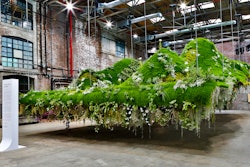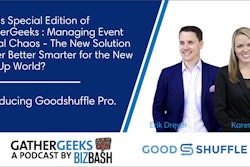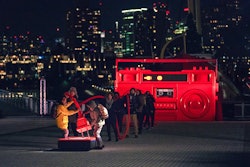
Each year, the event industry sees a number of prominent practices that serve to elevate events—and an equal amount of practices that do the exact opposite. As 2018 comes to a close, BizBash asked event professionals in the U.S. and Canada for their thoughts on the event practices that should be left behind this year. Here are the ideas, trends, and principles experts don't think should be carried on to 2019.
Instagram museums with no purpose. “As we were noted in Event Innovators 2018, we may be the godfathers of this trend," said Nicky Balestrieri, co-founder of the Gathery, a New York-based experiential design agency. "When we created La Maison Cointreau in 2011—the first version of creating these highly photogenic, timed, and scripted immersive experiences—our intent was to entertain, enliven, and educate people about the brand. Like events we created for British Airways, Refinery29’s 29Rooms, Remy Martin, Daily Harvest, and others, education—in a fun, beautiful way— was always at the core of the experience. A museum can’t be a museum if you don’t walk away having learned something.”
Thought leadership without thought. “Thought leadership—especially in the form of keynotes and panel discussions at events—is a popular marketing method where brands tap highly skilled and passionate talent to share best practices, knowledge sets, and case studies to ultimately fuel brand growth,” said Bruce Starr, co-founding partner at BMF Media Group, an experiential marketing agency based in New York, Los Angeles, and London. “But, this past year, I found myself attending panels at events including SXSW and Cannes Lions that were brimming with influencers giving overly promotional micro-presentations on being one’s ‘authentic self.’ Thought leadership is at its most effective when there is a perceived personal value to the audience. The audience must walk away feeling smarter and motivated—a la a 92Y panel or a TED Talk.”
Instagram worthiness over quality. “It seemed in 2018, many events had the mandate to prioritize a few Instagrammable moments above the quality and experience of the overall event itself,” said Candice Chan, partner at Candice & Alison Events Group, a Toronto-based event design agency. “Guests may post the beautifully staged photo, but they’re also posting the raw footage of the rest of the event on their stories, so it’s important that the experiences match—plus, let’s not forget their word of mouth. For 2019, let’s refocus event priorities based on quality, purpose, and creating well-rounded memorable experiences.”
Incredible creative on incredibly short deadlines. “When brands task us to conceive incredible, game-changing, creative ideas for events, our goal is always to exceed their expectations,” said Brian Diamond, C.E.O. and co-founder of the Visionary Group, an experiential marketing agency based in Los Angeles and New York. “When dealing with super fast deadlines, we find ourselves burning the candle at all imaginable ends, and we run the risk of meeting client expectations—but not exceeding them, or at least not to the extent that we know we’re capable of. In order for us to truly fire on all cylinders and obliterate expectations, in a good way, it’d be a real treat if we could leave inadequate deadlines in 2018. Even if that means a 25-hour turnaround over 24 hours—we’ll take it!”
Technology without purpose. “Technology has the opportunity to enhance our lives, but it comes at the peril of disconnecting us from other human beings,” said Balestrieri. “Interpersonal exchange is at the core of experience and event design and if technology doesn’t enhance that one end, it has no place in the design. Clients need to rethink the fascination with V.R., which literally removes you from interacting with people if it doesn’t have a purpose of priming you for real-life interaction.”
Information overload. “It’s common to think that content and branding need to fill up the entire event,” said Eddie Ricard, account executive at Ray Bloch Productions, a New York-based event production company. “This can be overwhelming and the message can get lost in the noise. I hope to see more time for audiences to take a breath, step outside the room, and network.”
Using paper. "One thing I would personally love to see in the new year is less use of paper. As we continue to evolve as an industry, it's been incredible to see all the amazing progress, [with planners] using items like Tossware and Wasara," said Alexandra Rembac, principal and creative director of Sterling Engagements, a Los Angeles-based event design and production company. "We recently worked with Volunteers of America-Greater New York for their annual winter gala, and they have done away with print tribute journals and have moved them online. I think the idea of doing massive tribute books to spread information is an amazing way to raise awareness to a host of supporters, but it can be very wasteful. I find not everyone departs events with them. I’d love to see more of what VOA-GNY's [vice president of communications and external relations] Rachel Weinstein is doing, in terms of putting those efforts online and having guests utilize online platforms for both live and silent auctions. I’m all about continuing to generate revenue from and for the books, but would love to see a smaller amount of paper used. The more we can do together to be mindful of printing and excess goods, the better."
Leave flower bombs in trash cans to the experts. “We loved when Lewis Miller took the approach of taking leftover materials from events and stuffing New York trash cans with their gorgeous oversized blooms; it combined re-use and surprise to offer joy to passersby,” said Balestrieri. “Of course, overabundance has always been a beautiful design tactic, and we employ it often in unusual settings to create the effect of unexpected luxury or whimsy. But trash cans should be for the Miller gang of geniuses.”



















